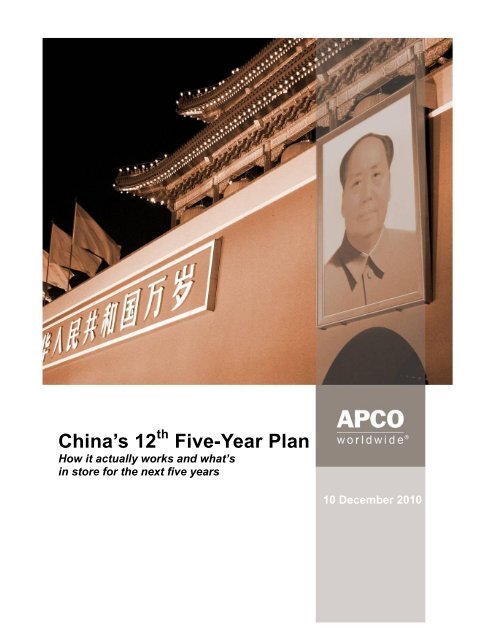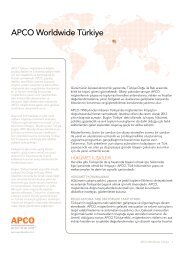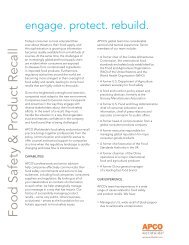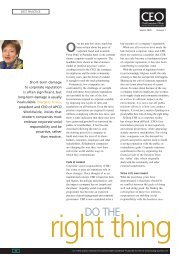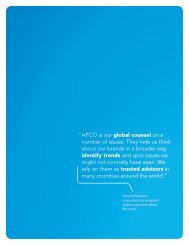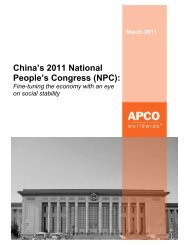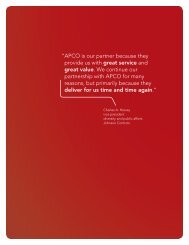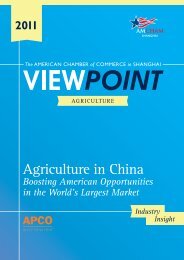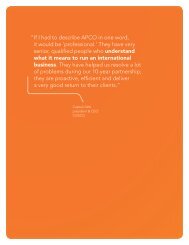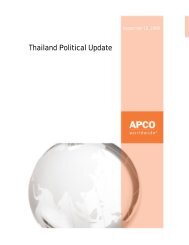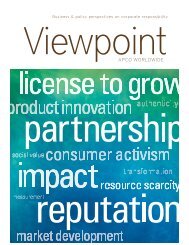China's 12th Five-Year Plan - APCO Worldwide
China's 12th Five-Year Plan - APCO Worldwide
China's 12th Five-Year Plan - APCO Worldwide
You also want an ePaper? Increase the reach of your titles
YUMPU automatically turns print PDFs into web optimized ePapers that Google loves.
China’s 12 th <strong>Five</strong>-<strong>Year</strong> <strong>Plan</strong><br />
How it actually works and what’s<br />
in store for the next five years<br />
10 December 2010
EXECUTIVE SUMMARY<br />
In October 2010, the Communist Party of China’s (CPC) Central Committee approved<br />
the guiding principles of China’s <strong>12th</strong> <strong>Five</strong>-<strong>Year</strong> <strong>Plan</strong> for National Economic and Social<br />
Development (FYP) (2011-2015). The National People’s Congress (NPC) will ratify the<br />
plan in March 2011. The 12 th FYP’s guiding principles will promote the government’s<br />
focus on “inclusive growth,” which means ensuring the benefits of economic growth are<br />
spread to a greater proportion of Chinese citizens. The plan’s key themes are<br />
rebalancing the economy, ameliorating social inequality and protecting the environment.<br />
Some important initiatives of the economic rebalancing theme in the 12 th FYP include a<br />
notional GDP growth rate target of 7 percent, promoting consumption over investments<br />
and exports, closing the income gap through minimum wage hikes and increased social<br />
safety nets, and a range of energy efficiency targets.<br />
Three sectors that will receive a major boost from the 12 th FYP are health care, energy<br />
and technology. Not only have segments of these sectors been singled out as China’s<br />
new Strategic Emerging Industries (SEIs), but they also dovetail with the 12 th FYP’s<br />
emphasis on “inclusive growth.” The government is encouraging foreign business<br />
participation in SEI development, but to what extent is a key question given China’s<br />
indigenous innovation drive.<br />
Foreign business can expect a changed cost structure during the 12 th FYP period.<br />
Increased costs could result from minimum wage and value-added tax hikes, raw<br />
material resource price reforms, and environment-related taxes. On the positive side,<br />
foreign business can expect the government to continue opening up China’s services<br />
sector, to further develop talent recruitment through education reform, and to strengthen<br />
the country’s intellectual property (IP) regime.<br />
Proposed reforms in the 12 th FYP will introduce additional stakeholders into various<br />
industries as well as new and complex regulations. Foreign business should continue to<br />
update their understanding of these new stakeholders and regulations.<br />
The implementation of certain 12 th FYP goals, such as increasing technological<br />
capabilities in a wide range of sectors, will have Chinese regulators welcoming advice<br />
and training from experienced foreign companies. This will offer opportunities for foreign<br />
companies to help shape implementation of the plan.<br />
CHINA’S FIVE-YEAR PLANNING PROCESS<br />
China’s policy process is not known for surprises; rather, reflecting the heritage of a command<br />
economy and the engineering background of many senior leaders, the Chinese policy<br />
establishment prefers a predictable and steady regulatory environment conducive to meeting its<br />
long-term development goals. China’s <strong>Five</strong>-<strong>Year</strong> <strong>Plan</strong> for National Economic and Social<br />
Development is a critically important tool used by the government to achieve its development<br />
objectives by mapping out in five-year cycles the country’s future progress via guidelines, policy<br />
frameworks, and targets for policy-makers at all levels of government.<br />
China’s FYPs are blueprints: they provide overall objectives and goals related to social and<br />
economic growth and industrial planning in key sectors and regions. Although most consider the<br />
FYP to be a single document, the FYP represents a complex web of Chinese policy-making,<br />
containing previously-implemented regional and long-term development plans and hundreds of<br />
targeted policy initiatives, all of which undergo constant review and revision over the course of<br />
the five-year cycle. Though this process might seem rather chaotic, the FYP process is<br />
1
increasingly standardized, open and subject to significant oversight within the wider<br />
bureaucracy.<br />
However, while the FYP formation process is becoming more efficient, effective implementation<br />
of FYP objectives remains difficult. Local government officials have been known to either<br />
slavishly follow plan targets or not follow them at all: during the 11 th FYP period (2006-2010) the<br />
country’s target annual GDP growth rate was routinely exceeded, while energy intensity targets<br />
led to forced electricity brown-outs in several cities in late 2010 to meet those targets. The 11 th<br />
FYP was also slow in applying fundamental structural changes to China’s economy that top<br />
leaders say are needed – for example, reducing fixed asset investment as a share of GDP and<br />
increasing domestic consumption.<br />
China’s next planning cycle is about to begin: In October 2010, the 12 th FYP’s Guidelines were<br />
approved by the CPC Central Committee and the NPC will ratify the plan’s Outline in March<br />
2011. We outline in more detail the cyclical nature of the preparation that goes into a FYP in an<br />
appendix (see page 10).<br />
THE TWELFTH FIVE-YEAR PLAN<br />
China’s NPC will soon release the 12 th FYP Outline. A focus of the 12 th FYP will be on the<br />
quality, rather than the rate, of growth, as well as ensuring more Chinese citizens benefit from<br />
that growth. Three key themes in the 12 th FYP are economic restructuring, social equality, and<br />
environmental protection.<br />
The two-year drafting process for the 12 th FYP (2011-2015) is nearing its end: On October 18,<br />
2010, nearly 200 senior leaders of the State Council and the CPC Central Committee endorsed<br />
the 12 th FYP Guidelines. Between now and December 31, 2010, the NDRC is encouraging the<br />
public, including foreign business, to submit their comments on FYP guidelines to<br />
125@ndrc.gov.cn. NDRC Director Zhang Ping has said that any potential revisions to the 12 th<br />
FYP, as well as the setting of the plan’s mandatory targets, will not take place until after these<br />
comments are fully digested. In March 2011, the 4 th Plenary Session of the 11 th NPC is<br />
scheduled to give the 12 th FYP Outline final approval. Although some details of the 12 th FYP<br />
may well be modified between now and the NPC’s action in March 2011, the broad themes of<br />
the plan should remain unchanged. Below is an approximate timeline of the 12 th FYP:<br />
The 12 th FYP is expected to pick up where the 11 th FYP (2006-2010) left off in terms of broad<br />
policy direction. The 11 th FYP was considered a major policy shift for the Chinese government<br />
as it moved away from a focus on “growth at any cost” toward a more balanced and sustainable<br />
growth pattern, under the “harmonious society” (和谐社会 or hexie shehui) and “scientific<br />
development concept” (科学发展观 or kexue fazhan guan) policy frameworks.<br />
The development of the 12 th FYP, however, is taking place in a markedly different internal and<br />
external environment: the global financial crisis, rising property prices and increased risk of<br />
social instability are all salient issues in China that will be prominently addressed by this plan.<br />
2<br />
© 2010 <strong>APCO</strong> <strong>Worldwide</strong> Inc. All rights reserved.
The financial crisis, in particular, has made Chinese officials aware of the importance of creating<br />
a growth model that moves away from the country’s overreliance on investments and exports<br />
and toward consumption-led growth. Increasing consumption would also help meet the<br />
government’s goal to raise income and social-benefit levels for all of China’s citizens.<br />
The 12 th FYP will also ensure policy continuity during the upcoming leadership transition in<br />
2012/13, when President Hu and Premier Wen are expected to be replaced by Xi Jinping and Li<br />
Keqiang. Xi has recently made public statements that he intends to follow Hu and Wen’s policy<br />
initiatives throughout the entire 12 th FYP period.<br />
RESTRUCTURING THE ECONOMY<br />
While economic rebalancing has been a government priority for many years, the sharp<br />
decrease in Chinese exports during the financial crisis, leading to the layoff of millions of factory<br />
workers, underscored the importance for Chinese decision-makers of moving to a more<br />
balanced growth structure. As China looks inward for growth, key objectives for the 12 th FYP will<br />
be to shift the relative importance of GDP components – from the current reliance on fixed asset<br />
investment (FAI) and exports – to a greater emphasis on consumption.<br />
Economic rebalancing has been a consistent priority for the government for several important<br />
reasons. These include the perceived unsustainability of maintaining an exceptionally high<br />
growth rate, large global trade and foreign exchange imbalances that have led to tensions<br />
between China and its major trading partners, the desire to spread the fruits of decades of<br />
growth to a wider proportion of the population and the inefficient use of resources that<br />
accompanies high levels of FAI by the government at all levels. The 12 th FYP will include<br />
policies that support a lower GDP growth rate, consumption-driven growth, upgraded industries,<br />
strengthened “national champions” and more backing for the government’s indigenous<br />
innovation drive.<br />
Growth rate: No explicit annual GDP growth target for the plan period has been<br />
announced, but there is widespread speculation that Chinese planners will target 7<br />
percent, down from 7.5 percent in the last plan. This goal will ensure that employment<br />
levels remain on target, allow the government to reach its 2020 GDP-per-capita goal,<br />
and help reign in excessive spending by provincial governments. A lower rate will also<br />
allow officials to reduce their focus on FAI and give them breathing space to set in train<br />
policies that will slowly increase consumption without having to unduly focus on<br />
ambitious growth targets. As the 11 th FYP period saw a GDP growth rate of nearly 11<br />
percent, most analysts agree that the government will try harder to actually enforce a<br />
lower rate this time around.<br />
Strategic Emerging Industries: No longer content with being considered the “world’s<br />
factory,” Chinese planners have included several preferential tax, fiscal and procurement<br />
policies designed to develop seven “Strategic Emerging Industries” (SEIs). <strong>Plan</strong>ners<br />
hope these industries will become the backbone of China’s economy in the decades<br />
ahead, and they have been chosen sectors where Chinese corporations are expected to<br />
succeed on a global scale. The seven industries are biotechnology, new energy, highend<br />
equipment manufacturing, energy conservation and environmental protection, cleanenergy<br />
vehicles, new materials, and next-generation IT. The government is reportedly<br />
prepared to spend more than RMB 4 trillion on these industries during the 12 th FYP<br />
period, with an aim to increase SEI’s contribution from today’s approximately 5 percent<br />
of GDP to 8 percent by 2015 and 15 percent by 2020.<br />
3
Consumption: Many expect<br />
that the government’s new<br />
catchphrase for the 12 th FYP<br />
period will be “inclusive growth”<br />
(包容性增长 or baorongxing<br />
zengzhang). The 12 th FYP is<br />
expected to strongly<br />
emphasize the importance of<br />
shifting to consumption-driven<br />
growth for several hoped for<br />
outcomes: reducing income<br />
disparity, moving away from<br />
FAI because of overcapacity<br />
concerns, as well as reducing<br />
China’s dependency on<br />
exports and thus reducing its current account surplus and need to maintain an artificially<br />
weak currency. While some Chinese experts are reportedly expecting consumption to<br />
rise from the current 35.1 percent to around 50-55 percent of GDP by 2015, a State<br />
Council official recently predicted that it would only increase to 40 percent (by<br />
comparison, the United States is currently 71 percent, Brazil is 63 percent, and India is<br />
54 percent). In order to enable consumption to grow quickly, the government plans to<br />
increase household disposable income, most likely through raised minimum wages and<br />
increased social safety nets, such as health care and social welfare payments.<br />
Industrial upgrading: Adding value to Chinese industrial output has been a consistent<br />
government priority and the 12 th FYP is expected to include policies that promote<br />
investments in new manufacturing equipment and technology, which in turn will assist<br />
China in meeting its energy efficiency goals (see “Protecting the Environment” below).<br />
Specific policies targeted at forcing sector consolidation can also be expected in several<br />
industries – the auto sector is a good example where the government wants to see the<br />
current 80 or so manufacturers reduced to only a few dozen tier-one and tier-two<br />
producers within a decade.<br />
PROMOTING SOCIAL EQUALITY<br />
President Hu Jintao and Premier Wen Jiabao have made development of a “harmonious<br />
society” a key priority for their administration, and the 12 th FYP will continue that focus under the<br />
rubric of “inclusive growth,” which means spreading the benefits of economic growth to a wider<br />
community. Interestingly, the 12 th FYP Guidelines has changed the previous creed of “Strong<br />
State, Wealthy People” (国强民富 or guoqiang minfu) into “Wealthy People, Strong State” (民富<br />
国强 or minfu quoqiang), implying that “Wealthy People” is now the greater priority. Not<br />
surprisingly, Hu and Wen are seeking to use the 12 th FYP to bed down their legacy as the first<br />
leadership team in the post-reform era with a strong focus on equality issues:<br />
Urban/rural divide: The divide in quality of life indicators between China’s urban and<br />
rural residents is especially large, even for a developing country, and contributes to a<br />
range of problems for the government, including mounting social unrest in rural areas.<br />
The 12 th FYP is expected to reduce this gap by focusing on increasing urbanization,<br />
partially by reforming the rigid and outmoded household registration system. The 12 th<br />
4
FYP will also provide improved social safety nets for China’s rural population, such as<br />
basic health care coverage and improved rural land distribution.<br />
Regional development: As<br />
labor costs rise on China’s<br />
eastern coast, the western<br />
region will be more attractive to<br />
manufacturers. Long a<br />
government priority to drive<br />
development in that relatively<br />
less affluent region, the<br />
government will continue to<br />
grow the West through<br />
preferential policies such as<br />
land credit, lower taxes and<br />
subsidies for manufacturers<br />
looking to locate inland.<br />
Income disparity: While a<br />
small proportion of individuals<br />
have become extremely<br />
wealthy, the income of many<br />
citizens has not kept pace with<br />
economic growth over the past decade. The 12 th FYP will help increase income through<br />
raising minimum wage (for example, the Beijing government has recently announced its<br />
plan to increase minimum wages by 40 percent by 2015). Other policy tools will include<br />
the expansion of the government-funded social welfare and health care system and<br />
promoting labor-intensive service industries. Improved livelihoods are in turn expected to<br />
boost consumption as a percentage of GDP growth, a key goal for the 12 th FYP.<br />
PROTECTING THE ENVIRONMENT<br />
China faces severe environmental degradation for many reasons, including rapid<br />
industrialization, a reliance on coal as an energy source, a relatively large and energy-intensive<br />
manufacturing industry and lax environmental protection and enforcement. The 12 th FYP is<br />
expected to focus on reducing pollution, increasing energy efficiency and ensuring a stable,<br />
reliable and clean energy supply. China’s environmental goals will likely have a far-reaching<br />
effect as they will impact and shape a range of other industrial policies in a multitude of sectors.<br />
Energy conservation: The 12 th FYP is expected to contain preferential measures for<br />
developing energy-efficiency technology, as well as an expected mandatory energy<br />
emissions target of approximately 17 percent (down from the 11 th FYP’s 20 percent).<br />
Environmental quality: For the first time, this plan could contain green indicators that<br />
will hold local government officials accountable for green development, such as water<br />
consumption per unit of GDP, and proportion of GDP that is invested in environmental<br />
protection. The 12 th FYP is rumored to include a new carbon emissions target that is in<br />
line with China’s recent pledge to reduce 40-45 percent of carbon per unit of GDP by<br />
2020, especially for high-polluting and high-energy usage sectors. In order to meet that<br />
commitment, government officials have recently made statements that a carbon tax may<br />
be implemented by 2013, as well as some type of carbon trading system by 2015, the<br />
form of which is currently being debated behind closed doors. The 12 th FYP also will also<br />
5
contain measures for ensuring better environmental quality for cities and towns,<br />
including a “blue sky day” target and other mandatory emissions targets.<br />
New energy: The<br />
12 th FYP reflects<br />
China’s pledge to<br />
have 15 percent of<br />
its energy come<br />
from non-fossil<br />
fuels by 2020 (from<br />
8.3 percent in 2009<br />
to approximately 11<br />
percent by 2015).<br />
The plan includes a<br />
cap on domestic<br />
coal production,<br />
China’s largest<br />
energy source and a major contributor to the country’s environmental problems. The<br />
plan also contains significant support for nuclear and hydropower development with wind<br />
power seeing a threefold expansion in capacity. Domestic natural gas consumption will<br />
double over the 12 th FYP.<br />
SECTORS POISED TO BENEFIT<br />
<strong>APCO</strong> has identified three sectors that will particularly stand to benefit as a result of the 12 th<br />
FYP: health care, energy/environment, and technology. Not only have certain segments of<br />
these sectors been identified as “Strategic Emerging Industries,” but they dovetail with the<br />
emphasis of the 12 th FYP on “inclusive growth,” another reason why they can expect to receive<br />
special policy backing and funding from the government.<br />
In combination with heavy government investment and preferential tax, fiscal, and procurement<br />
policies, government officials have emphasized the important role foreign investment will play in<br />
the development of the healthcare, technology, and energy & environment sectors. Foreign<br />
business has been encouraged to establish R&D bases in China and will be allowed to apply<br />
with Chinese firms for government-funded R&D projects. However, some uncertainty remains<br />
around the extent to which foreign companies will be allowed to participate in the growth in<br />
these sectors given the government’s wider indigenous innovation goals. Protection of foreign<br />
intellectual property (IP) is another concern.<br />
HEALTH CARE<br />
The 12 th FYP will focus on creating a modern health care industry through continued health care<br />
reform, consolidating the pharmaceutical distribution sector and encouraging significant<br />
investments in biotechnology.<br />
Health Care System Reform Continued<br />
In 2009, China released an aggressive health care reform plan that included short-term<br />
objectives such as greatly expanding access to basic medical coverage for citizens,<br />
modernizing the country’s health care infrastructure and improving grassroots health care<br />
delivery. The 12 th FYP is expected to support these health care system reforms with specific<br />
6
policies and funding, including broader basic health care coverage, expanded infrastructure for<br />
grassroots medical networks, public awareness in disease prevention, improved health care<br />
administration, creation of national health care benchmarks and standards and heavy<br />
investments in health care IT.<br />
Pharmaceutical Sector Restructured<br />
China hopes to consolidate and commercialize its pharmaceutical distribution industry<br />
throughout the 12 th FYP period. The current structure of many of the 13,000 small distribution<br />
enterprises operating largely within the grey economy is a contributing factor to the high markup<br />
of drugs and risks for consumers buying fake or shoddy products. Along with establishing<br />
large national pharma champions, the government will also consolidate many of the smaller<br />
drug distribution companies in an effort to bring pharmaceutical production and sales closer<br />
together, thereby reducing drug prices. Coupled with stringent regulations, integration will take<br />
place through preferential policies and financial support to encourage larger companies to<br />
acquire smaller ones. The government plans to consolidate the industry around one or two<br />
national-level companies, with revenues reaching RMB 100 billion. At the regional level, the<br />
government plans to create 20 major companies, with sales of nearly RMB 10 billion each.<br />
Biotechnology Promoted as an SEI<br />
The government has announced that biotechnology will be one of China’s key SEIs, most likely<br />
due to the sector’s potential for large productivity gains and its ability to solve health problems<br />
associated with China’s rapidly aging society. The plan will support the development of<br />
innovative biotech products, high-end medical devices and patented medicines. The<br />
government will reportedly put forth a spending package of more than RMB 12 billion for R&D of<br />
new drugs from 2011-2015.<br />
ENERGY AND THE ENVIRONMENT<br />
Meeting China’s increasing energy demand, while simultaneously reducing pollution, has been<br />
a long-term priority of the government. During the 11 th FYP, for example, the government’s<br />
allocation of RMB 200 billion for energy efficiency and environmental protection measures<br />
allegedly created a large knock-off effect of generating an additional RMB 2 trillion in economic<br />
activity. The government has said that <strong>China's</strong> investment in the environmental protection<br />
industry during the <strong>12th</strong> FYP period will exceed RMB 3 trillion, with the industry growing by 15-<br />
20 percent annually, with a huge potential for international cooperation.<br />
In terms of energy sources, China’s overall energy objective during the 12 th FYP will be to<br />
maintain coal as the dominant source of energy, while steadily increasing the proportion of<br />
renewable energy.<br />
Consolidation Continues in Coal Sector<br />
The government plans to continue with the consolidation of coal mining companies: about<br />
11,000 coal enterprises will be reduced to 4,000, with eight to 10 coal companies expected to<br />
account for nearly two-thirds of all coal production by 2015.<br />
Nuclear and Hydropower Big Winners<br />
The government has announced that it will structure new energy policies around hydro and<br />
nuclear power. China’s 11 nuclear power reactors currently account for 1 percent of the nation’s<br />
total power capacity, but by 2015 will double, with 25 nuclear power plants in operation.<br />
Hydropower’s capacity will increase by 50 percent by 2015.<br />
7
Further Development of the Power Grid<br />
A key government priority is the further development of the country’s ever-struggling power grid<br />
(by the end of 2009, 30 percent of <strong>China's</strong> wind farms weren't grid-connected), with plans for the<br />
large-scale construction of a smart grid beginning over the 12 th FYP period. State Grid's<br />
investments will reportedly exceed RMB 17 billion during this time.<br />
Heavy Spending for Energy and Environment Sectors<br />
Three of the seven SEIs are devoted to the energy and environment sectors: “Energy Efficiency<br />
and Environment,” “New Energy” and “New Energy Vehicles.” For the new energy sector, China<br />
aims to develop advanced technology in the nuclear, solar and wind sectors. For energyefficiency<br />
and environmental conversation sectors, the focus will be on waste recycling and<br />
clean coal technologies. For new energy vehicles, China is focused on battery cell technology<br />
and is also aiming for an annual production of 1 million electric vehicles by 2015.<br />
TECHNOLOGY<br />
A key priority of the 12 th FYP is for China to transition from “Made in China” to “Designed in<br />
China.” In order to achieve this goal, the government plans to heavily invest in science and<br />
technology education and R&D, further develop China’s intellectual property rights system and<br />
support “Next-Generation IT” as an SEI. China’s indigenous innovation drive will also continue<br />
to play a central role in this sector throughout the 12 th FYP period.<br />
Indigenous Innovation Supported<br />
China hopes to improve indigenous innovation capabilities in technology through the use of<br />
several tools, including:<br />
Research & Development: The government will heavily invest in science and<br />
technology R&D in order to bring about key breakthroughs in targeted technology<br />
subsectors, such as core electronic devices, integrated circuits, life sciences, space,<br />
marine, earth sciences and nanotechnology.<br />
Intellectual Property: China plans to continue its efforts to strengthen IPR creation,<br />
use, protection and management, particularly through support for companies that<br />
provide those services. This is an area where there is much room for progress.<br />
Administration: The 12 th FYP plans to strengthen fiscal and financial policies that<br />
support high-tech industry, including updating research funding management and<br />
venture capital investment systems.<br />
Commercialization: A key goal - and challenge - for China will be to get the research<br />
undertaken at government-sponsored universities and research institutions to the<br />
marketplace. The government hopes that both large enterprises and SMEs will increase<br />
their R&D investments as well.<br />
“Informatization” Increased<br />
China plans to upgrade the technological capabilities of private and public services, including<br />
“triple play” services (the convergence of telecom, broadcasting and Internet networks), ecommerce,<br />
and e-government and statistics systems.<br />
Education Sees Heavy Investment<br />
The 12 th FYP stresses the need for higher education reform in science and technology, as well<br />
as the importance of developing a human resources strategy for finding and nurturing talent.<br />
8
Initiatives include improving scientific achievement evaluations and rewards system,<br />
encouraging even more highly-educated overseas Chinese to return to China to work and<br />
increasing investments in human capital.<br />
Next-Generation Information Technology Singled Out<br />
Next-generation IT has been selected as one of China’s SEIs. China is particularly interested in<br />
accelerating the creation of next-generation information networks, mobile communication and<br />
the Internet. In addition, the government plans to invest in R&D of the "Internet of things" and<br />
cloud computing, and develop digital and virtual technologies.<br />
IMPLICATIONS FOR FOREIGN BUSINESS<br />
Industrial upgrading presents both opportunities and challenges: The government’s plan<br />
to increase SEI’s share of GDP by government investment and fiat should yield significant<br />
opportunities for foreign companies due to the incentives that will be created for private<br />
investment. However, given China’s current drive to develop its indigenous innovation<br />
capabilities, these preferential policies may be biased toward domestic firms. This could be<br />
additionally problematic if the government decides to use its government procurement market to<br />
develop these industries, given its earlier pledge to develop a national procurement list that<br />
favors domestic companies. Foreign firms must also be aware of the government’s proclivity to<br />
“re-innovate” foreign technology. Either way, foreign business should monitor China’s SEI policy<br />
closely and look for opportunities to inject comment and input into its development. Foreign<br />
firms may also consider the use of partnerships with local companies to better access the<br />
significant funding opportunities available.<br />
Changes to the business environment: If the 12 th FYP objectives are fully implemented,<br />
foreign business can expect costs to both rise and fall. Increased costs could result from<br />
proposed minimum wage hikes, value-added tax hikes, raw materials resource price reforms, as<br />
well as the implementation of potential environment insurance plans, carbon markets and other<br />
environment-related taxes. However, there are benefits to foreign business embedded is this<br />
plan, as well. Foreign companies can expect the government to continue its focus on opening<br />
up China’s service sectors, further developing its talent recruitment through education reform<br />
and strengthening the country’s IP regime.<br />
A more complex operating environment: Proposed reforms in the 12 th FYP will introduce<br />
additional stakeholders into various industries. Foreign business should continue to update their<br />
understanding of relevant stakeholders emerging as a result of the 12 th FYP, the development<br />
of SEI and other reforms, and begin developing targeted engagement strategies. The plan will<br />
also likely introduce a host of new regulations. A clear understanding of the changes in China’s<br />
regulatory environment as a result of these developments, coupled with robust relationships<br />
with key institutions and actors involved in its execution, will enable foreign business to better<br />
monitor potential issues and effectively inject their views into the policy process.<br />
Seeking views from foreign businesses: The implementation of certain 12 th FYP goals, such<br />
as increasing technological capabilities in a wide range of sectors, will have Chinese regulators<br />
welcoming advice and training from experienced foreign companies, offering an opportunity to<br />
help guide implementation. This assistance could range from informal consultations to more<br />
9
formal programs under the rubric of corporate social responsibility, improving understanding and<br />
institutionalizing government relationships.<br />
APPENDIX: FIVE YEAR PLAN DEVELOPMENT<br />
The FYP as we know it today is radically different from the overarching blueprint imported from<br />
the USSR at the time of the PRC’s founding. First of all, the name has been changed from “计划<br />
or jihua” (plan) to “规划 or guihua” (program) reflecting its transformation from a straightforward<br />
list of economic objectives to a more general guideline for both economic and social policy<br />
goals. Second, over the past three decades, the government has ceded many of its former<br />
powers to the market, and policy control has been relatively decentralized. This means the<br />
implementation of any nationwide policy necessarily requires a lengthy process of consultation<br />
and coordination. Third, the document that most believe to be the FYP is merely the document<br />
that sets off the five-year policy cycle. Hundreds, if not thousands, of policies, regulations and<br />
plans are developed by all levels of government over the entirety of the five-year period. Finally,<br />
even though it remains something of a closed box, light is increasingly being shed on the FYP<br />
process itself: at several points throughout FYP development and implementation, China’s<br />
planners seek the expertise of hundreds, if not thousands, of Chinese officials at all levels of<br />
government, as well as the views of domestic and foreign institutions. The received views are<br />
then funneled up and down government channels, and some of the ideas are integrated into the<br />
plan itself.<br />
The following is a description of the FYP five-year policy cycle:<br />
<strong>Year</strong> 1<br />
“Outline” ratified in<br />
March<br />
<strong>Year</strong>s 1-5<br />
Policies Executed<br />
<strong>Year</strong> 3<br />
Mid-term review<br />
<strong>Year</strong>s 4-5 of the Previous FYP Cycle: Next FYP Drafted<br />
Near the end of the outgoing FYP, the NDRC’s Strategic <strong>Plan</strong>ning Department begins preparing<br />
for the next plan by convening a task force of specialists that will create draft proposals<br />
regarding the multitude of issues that the government will address within the plan. The task<br />
force will receive high-level guidance from CPC organs such as the Central Committee and the<br />
Politburo.<br />
While the NDRC task force begins its preparations, municipal and provincial-level governments<br />
begin drafting their own policy proposals with their own task forces and experts. Draft proposals<br />
from all levels of government are vigorously debated in house and then ultimately validated by<br />
outside third parties, including contracted universities, think tanks and research institutions both<br />
foreign and domestic.<br />
10<br />
<strong>Year</strong>s 3-5<br />
Revision<br />
<strong>Year</strong>s 4-5<br />
Next FYP drafted<br />
<strong>Year</strong> 5<br />
“Guidelines”<br />
published in October
<strong>Year</strong> 5 of the Previous FYP Cycle: Guidelines<br />
Formed<br />
In the last year of the outgoing FYP, national<br />
ministries and local governments will submit their<br />
finalized draft proposals to NDRC, who will then lay<br />
out the FYP’s basic overarching principles. The<br />
guiding principles go through two rounds of review<br />
and revision by the Central Committee, and then the<br />
“Guidelines” (建议 or jianyi) are published during its<br />
October plenary session. The Guidelines’<br />
publication sets off numerous local government<br />
plenaries who in turn will publish their own local FYP<br />
Guidelines. After publication of these Guidelines,<br />
public opinion, both foreign and domestic, is sought.<br />
<strong>Year</strong> 1: Broad Outline Ratified<br />
A more detailed version of the FYP’s guidelines, the “Outline” (纲要 or gangyao), is submitted to<br />
the NPC for ratification the following March. This document is what most consider to be the<br />
“<strong>Five</strong>-<strong>Year</strong> <strong>Plan</strong>.” While more detailed than the Guidelines (it contains specific plan targets, see<br />
“FYP Targets”), the Outline is still a very broad policy document. Once the Outline is endorsed<br />
by the NPC, each province, municipality and industry regulator will then issue their own Outline,<br />
followed by detailed policies called “Special <strong>Plan</strong>s” (专项规划 or zhuanxiang guihua).<br />
<strong>Year</strong>s 1-5: Policies Executed<br />
“Special <strong>Plan</strong>s,” created at all levels of government, are the first documents that specify how the<br />
broad objectives of the FYP are to be realized. These policies are detailed, covering specific<br />
industries and issues as well as plan administration and implementation. Departments named in<br />
Special <strong>Plan</strong>s then issue work plans that explain how they are to fulfill their responsibilities.<br />
Local DRCs (NDRC’s provincial surrogate) are usually the lead agency for most Special <strong>Plan</strong>s.<br />
The next step is the issuance of a plethora of policy documents that will detail how<br />
implementation will occur on the ground.<br />
<strong>Year</strong>s 3-5: <strong>Plan</strong> Monitored and Reviewed<br />
Throughout the entire FYP period, local DRCs will monitor the plan’s quantitative and qualitative<br />
indicators and funnel those findings up to NDRC. The FYP also goes through a formal mid-point<br />
review process at all levels of government, with government officials and outside experts<br />
participating, including the World Bank. The review’s objective is to monitor the FYPs progress<br />
as well as determine whether its targets need to be modified. At the mid-point review, preparing<br />
for the next FYP will begin, and the FYP cycle starts anew.<br />
FYP TARGETS<br />
Out of the 22 specific targets contained in the 11 th FYP Outline, eight were compulsory (“restrictive” or<br />
约束性 or yueshuxing), including energy efficiency, pollution control, and population reduction. The<br />
other 14 targets were guidelines (“predictive” or 预期性 or yuqixing) and did not carry as much weight.<br />
The incentive for local officials to execute the targets highly valued by Beijing (like energy efficiency) is<br />
closely tied to the official’s career progression within the CPC.<br />
11
CONTACT INFORMATION<br />
For further information on how <strong>APCO</strong> <strong>Worldwide</strong> can help your organization understand China’s<br />
political/regulatory environment, please contact:<br />
BEIJING<br />
Greg Gilligan<br />
Managing Director, Beijing<br />
16 th Floor, NCI Tower<br />
12 A Jianguomenwai Avenue<br />
Chaoyang District, Beijing, China<br />
100022<br />
Phone: +86.10.6505.5127<br />
Fax: +86.10.6505.5257<br />
ggilligan@apcoworldwide.com<br />
GUANGZHOU<br />
Ouyang Jun<br />
Chief Representative<br />
Room A1309, Center Plaza Tower A<br />
161 Linhe Xi Road, Tianhe District<br />
Guangzhou, China 510620<br />
Phone: +86.20.3825.1955<br />
Fax +86.20.3825.1016<br />
jouyang@apcoworldwide.com<br />
SHANGHAI<br />
Murray King<br />
Managing Director, Greater China<br />
2102 CITIC Square<br />
1168 Nanjing Road West, Shanghai,<br />
China 2000041<br />
Phone: +86.21.5298.4668<br />
Fax: +86.21.5298.4669<br />
mking@apcoworldwide.com<br />
HONG KONG<br />
Sukyi Yau<br />
Senior Vice President<br />
1903, 19/F, Cambridge House,<br />
Taikoo Place<br />
979 King’s Road, Hong Kong<br />
Phone: +852.2866.2313<br />
Fax: +852.2866.1917<br />
syau@apcoworldwide.com<br />
12


